Despite surprising levels of controversy surrounding it upon release, this is an excellent model that reflects scientific understanding to the best detail currently possible.
Pteranodon is the default popular image of the pterosaurs (often misidentified broadly as “pterodactyls” – although Pteranodon IS nestled deep in suborder Pterodactyloidea). Between its large size, catchy name, and signature head crest, the “toothless wing” is every bit as iconic as its Mesozoic counterparts like Tyrannosaurus and Triceratops. Everyone knows what a Pteranodon is… right? As is turns out, not everyone does. In recent years, controversy in the paleontological community has grown around what legitimately counts as the animal Pteranodon. Even though there are over a thousand specimens in museums around the world, many of these fossils have been reclassified and reclassified AGAIN into and out of the Pteranodon genus. There are currently only two guaranteed Pteranodon species – P. longiceps and P. sternbergi – and the latter may end up being its own genus (Geosternbergia) as well. With this in mind, any serious artist needs to be careful in reconstructing the animal. Paleoartists always do, of course, but Pteranodon is a good example of how shaky even “established” iconic genera can be. Enter, then, the Safari Ltd. 2019 Pteranodon.
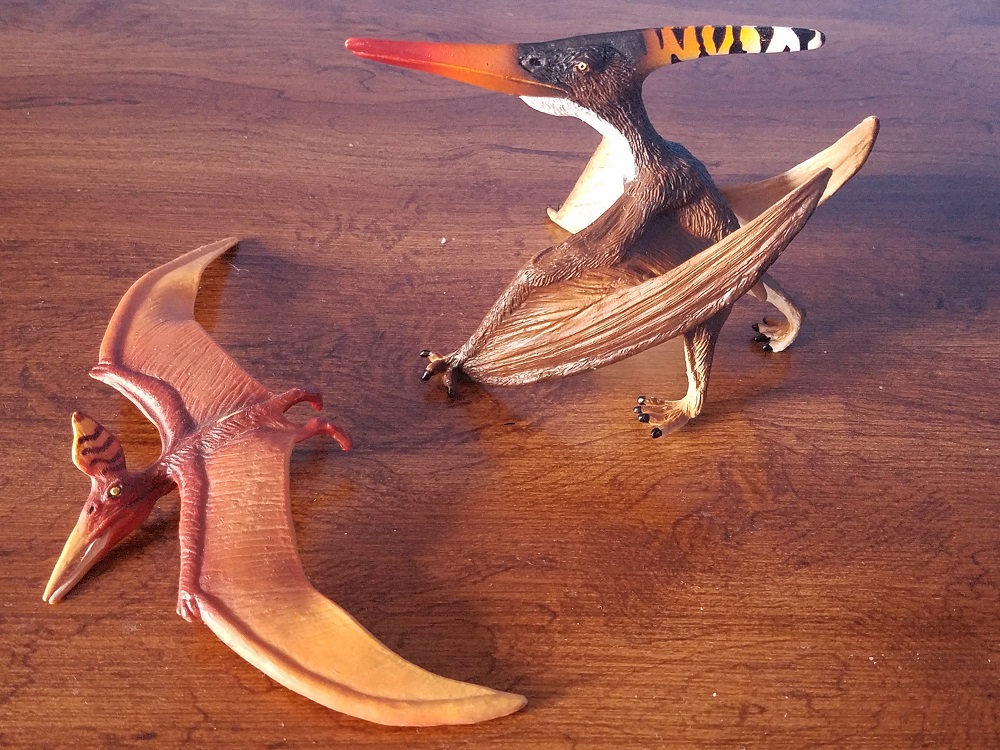
Safari’s new sculpt, produced by regular Doug Watson, is based on the species P. longiceps, the one guaranteed valid species in the genus. Scaled at 1:22, the figure measures 9 cm tall (3.375 in) and roughly 12 cm long (4.5 in) from beak to toe. The individual is a male, evidenced by the long crest; females had much stubbier crests. The figure is posed upright on all fours, in a nice change of pace from the wings-spread-in-flight pose typically seen in pterosaur toys. Rather than ungainly, Safari’s Pteranodon looks like it could be rather adept on the ground, which fits with contemporary understanding of pterosaur biology. Gone are the days of sprawling beasts who were helpless on the ground; this looks like a real animal fully comfortable in its element.
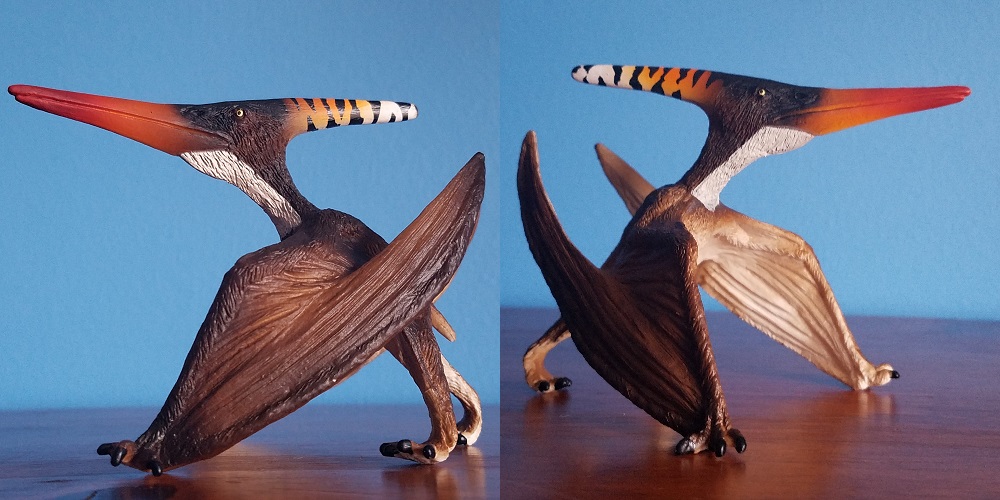
The first major detail which should be addressed is the head. Doug Watson has based this model’s appearance on the holotype specimen of P. longiceps. As such, the model is sculpted with a bill that is predominantly straight. This is a departure from typical reconstructions today, which tend to depict Pteranodon with an upturned bill, and has already proved a controversial choice for some people.

Not helping the fact is the tendency of the production models to warp, giving the bill a subtle downwards curvature (this can be remedied with hot water). Critics may want to point out that the holotype is a smaller, presumed female specimen as opposed to the large male the model depicts. However, considering how the genus as a whole is undergoing a lot of inspection, I think Watson’s choice was a perfectly reasonable one, especially since the holotype is probably the ONLY specimen we can currently say is irrefutably Pteranodon. Time will tell how well this choice holds up, but that’s nothing new for paleontology.
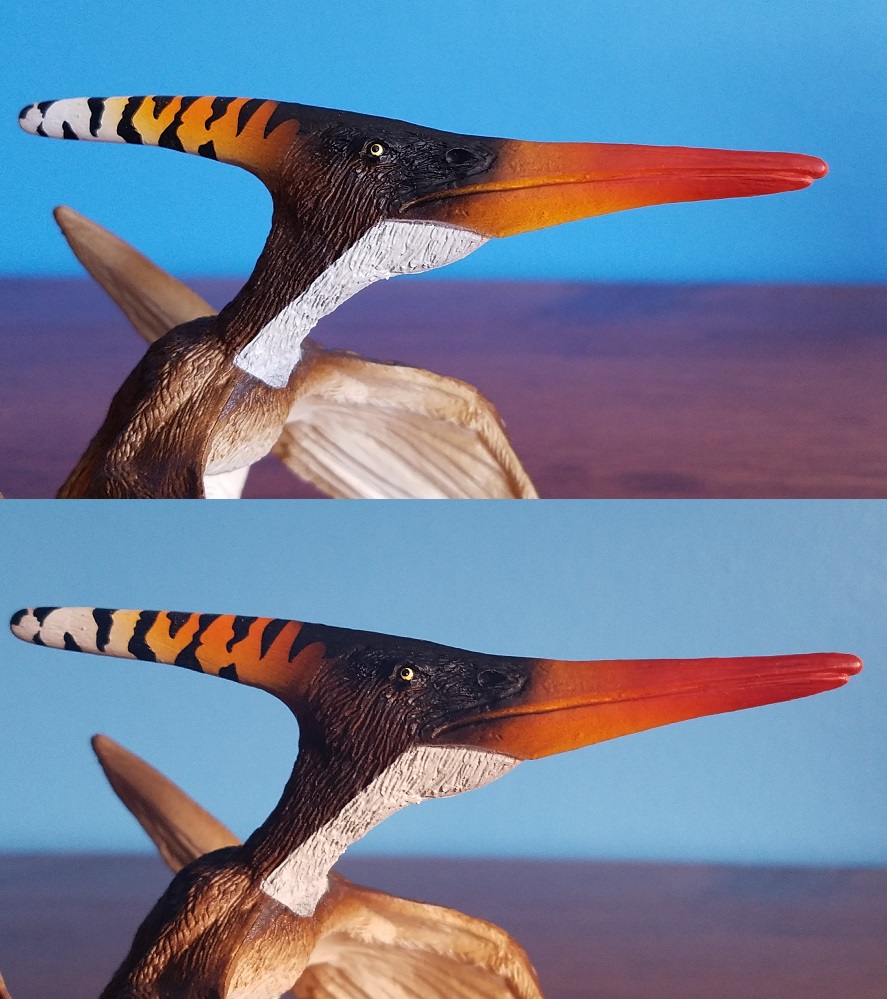
Elsewhere, sculpting of the model is equally researched and realized. The quadrupedal pose, with the wrist joints jutting out like reversed elbows, can look rather funky to viewers, but keep in mind that pterosaurs were inherently funky-looking creatures! Pteranodon‘s wrist bones were longer than the other arm bones combined, propping up the body as though it was walking with stilts. The model accurately captures this stance, with the back legs straight up and the forefeet splaying their fingers in a manner reflecting known pterosaur trackways. From a somewhat perfunctory look at skeletons and diagrams, I certainly don’t see any noticeable errors in proportions or anatomy. This is a lean, but not scrawny, animal. Its wings are long and strong, and the animal looks ready at a moment’s notice to take flight or break into a run.
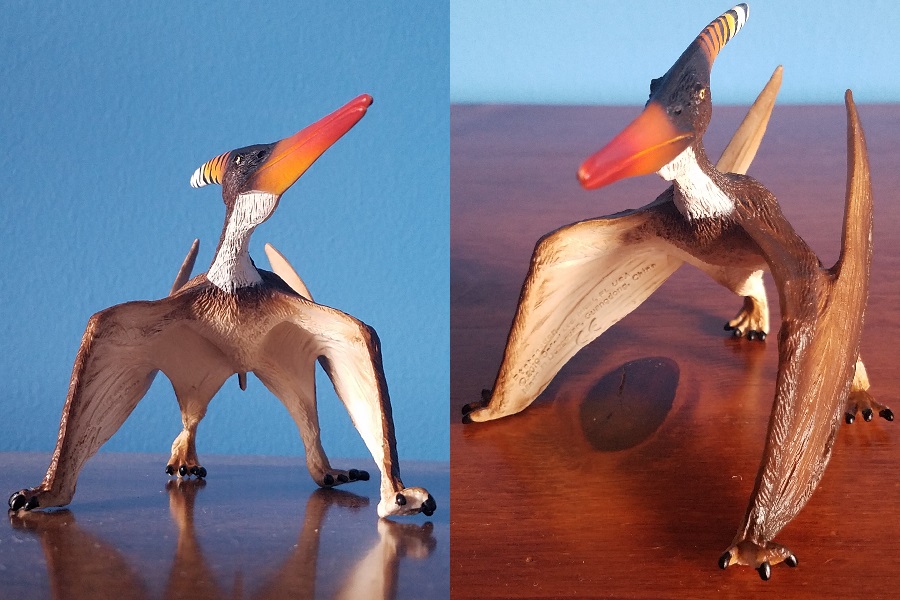
A textured coat of hair-like pycnofibers covers the body and limbs. Pterosaur specimens with preserved integument (not Pteranodon specifically, but numerous other genera) indicate that these animals were entirely covered in these pycnofibers, with scales found only on the soles of the feet – another detail which is, in fact, recreated on this model if one inspects it closely. The wing membranes feature ample crease and stretch lines, conveying their tight elastic nature. The exact point of attachment for the membranes to the hind limbs are a subject of ongoing debate. For this model, the membranes are depicted attaching just above the ankles, with a slighter membrane on the inside of the legs. Overall, Pteranodon has a slender physique, but not bony – pterosaurs would have been well-muscled animals, and Pteranodon‘s central body in particular appears very robust for its size.

High-contrast color schemes tend to be more common in nature than heavily saturated ones, and Pteranodon is depicted here in predominantly brown and white coloration, reminiscent of some seabirds. Darker tones are applied to the head and back, and lighter ones along the membranes. The bill and crest are more striking in appearance, displayed in a gradient from bright red to orange to white, with irregular black striping along the crest. It’s not hard to imagine that Pteranodon would have used its large skull for display among its species, as modern birds and certain reptiles today do. The eyes are neatly painted yellow with a faint gloss, providing the final detail in a convincingly lifelike depiction of this great prehistoric flyer.
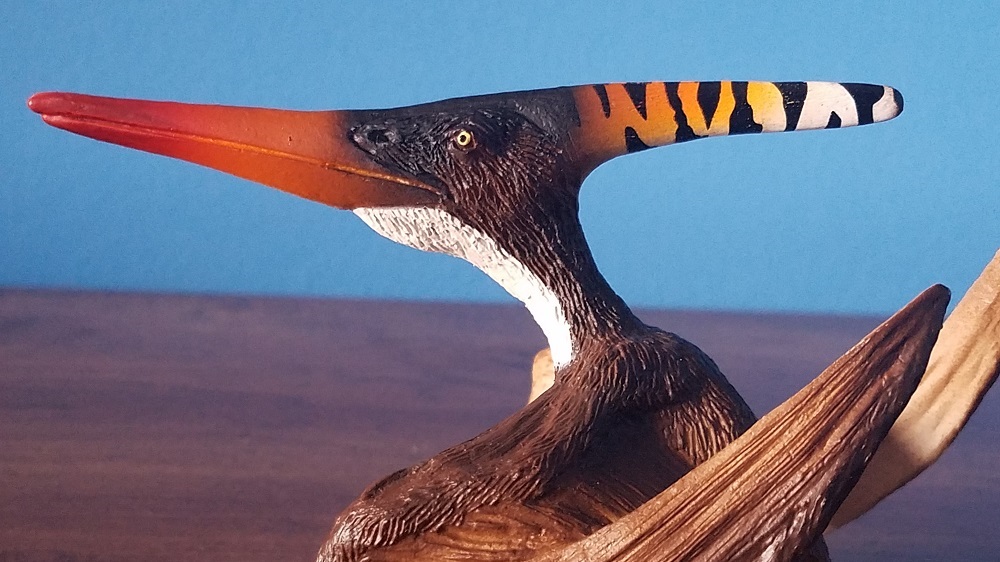
With all that is going on in the scientific community regarding the famous “Toothless Wing,” Doug Watson and Safari Ltd. have nonetheless produced an excellent model that reflects scientific understanding to the best detail currently possible. Any fan of the mighty winged reptiles should make an effort to obtain this figure. Thankfully, it is quite easy to find; you can purchase the model directly from Safari’s website, or from any of your regular prehistoric toy retailers.
Disclaimer: links to Ebay and Amazon on the DinoToyBlog are affiliate links, so we make a small commission if you use them. Thanks for supporting us!




From my ignorance in paleontology and from my point of view as a collector the pteranodon of Safari is undoubtedly the best pteranodon made to date. It is a pterosaur that is at the same height in quality and beauty as the dimorphodon, cauiajara and guidraco of Collecta to name three examples.
Excellent review. Well done especially on writing the most easily digestible explanation of the bill situation I’ve read; now I know where to look if I get into a debate about it 😉
Enjoyed your great review. Thankx
After reading the debates in the forum threads, the bill situation was something I wanted to take extra care in explaining. I’m glad to hear I accomplished that! 🙂
Great job with the review; very thorough!
Fine review, especially since it addresses the reasoning behind the straight bill. Methinks the Bullyland toy can finally kiss its position atop the heap goodbye.